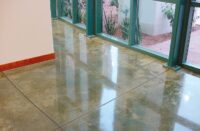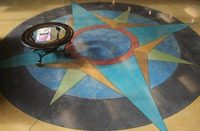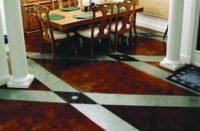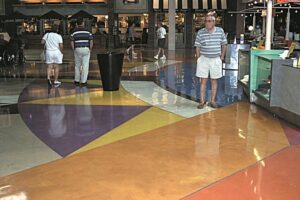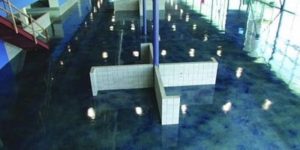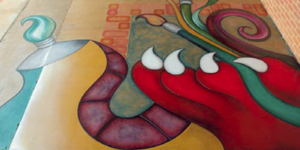Mike Miller isn’t crazy about the term “architectural concrete.” He doesn’t like “decorative concrete” much either.
 Miller considers himself an artist first and a concrete contractor second. To his ears, “architectural concrete” sounds too modular, too forced. Decorative concrete? “To me, it implies someone putting icing on a cake.” He prefers “sensory concrete,” which reflects the vision of his company: To give the material a voice.
Miller considers himself an artist first and a concrete contractor second. To his ears, “architectural concrete” sounds too modular, too forced. Decorative concrete? “To me, it implies someone putting icing on a cake.” He prefers “sensory concrete,” which reflects the vision of his company: To give the material a voice.
Miller, a well-known consultant to the industry and founder of The Concretist Inc. in Benicia, Calif., respects the properties of concrete. He embraces its cracks, imperfections and variations, incorporating all of its characteristics, warts and all, into his work. In fact, he thinks the materials are more in control over the final product than he is.
 |
 |
By contrast, consistency was the watchword for Miller when he started out. He was raised in the business. Miller’s father was a cement salesman who eventually became the general manager of a cement manufacturer. Miller began as a cement broker and later worked for L.M. Scofield Co., a company that prided itself on the uniformity of its concrete-coloring products.
But in Miller’s travels around the country as a technical troubleshooter for Scofield, he found the variations much more interesting than the consistencies. Concrete in New Jersey looked one way, but in Hawaii the character was different. Spilled suntan lotion that resisted Scofield’s stain may have been a mistake, but Miller thought it might look charming in a certain setting. Another snafu, fertilizer spilled onto wet concrete, created interesting variegated patterns.
 |
 |
“I had a lot of ideas, things I wanted to try, and it got to the point where I would burst if I didn’t try some of these ideas,” Miller says, “so I took off on my own.”
He no longer strives for uniformity, but for a more natural, free-spirited look in his floors, walls, counters and fireplaces. His floors have featured stylized, yet realistic, colorful autumn leaves, sumptuous grapes, and sea-inspired kelp, nautilus and fossilized fish designs. The Concretist, which employs 13, is all about collaboration, joint ventures and informal partnerships. Kelley Burnham, who coined the term “sensory concrete,” is Miller’s business partner and chief designer. The Concretist’s artists and craftspeople may share their talents or work alone if they choose. Miller has a strong technical background, bringing a touch of the mad scientist to his artistic side.
 Miller says that disasters are temporary to Concretist artists. They can quickly adjust to the vagaries of the concrete, stains and other materials they use. “Every job we do is not perfect. In fact, every job is loaded with mistakes, but people are over the moon with almost every job.” Miller’s philosophy brings to mind Miles Davis, the jazz trumpet innovator, who said, “Do not fear mistakes, there are none.”
Miller says that disasters are temporary to Concretist artists. They can quickly adjust to the vagaries of the concrete, stains and other materials they use. “Every job we do is not perfect. In fact, every job is loaded with mistakes, but people are over the moon with almost every job.” Miller’s philosophy brings to mind Miles Davis, the jazz trumpet innovator, who said, “Do not fear mistakes, there are none.”
Miller says: “I try to let the concrete do what concrete wants to do on its own, and not beat myself up too much to get it to do things it doesn’t naturally want to do.”
His deep experience with various coloring systems and staining techniques make him a much-sought-after consultant to the industry. When he was younger, those talents would show up in layers and layers of multiple colors and intricate details — the concrete artist’s version of a show-offy guitar riff. Huge projects were once Miller’s forte, such as his massive floors for Las Vegas casinos, but he’s been scaling back ever since. He’s more interested in smaller projects that require far more thought, research and design. “Less is more” is his design philosophy now. (Miles Davis said: “Don’t play what’s there, play what’s not there.”)
One of his favorite projects is his recent collaboration with Bob Harris of the Decorative Concrete Institute to create a sales floor in a Whole Foods Market in Duluth, Ga., that is adjacent to the Chattahoochee River. They created a hand-sculpted, stylized map of the rich natural history of the river that winds 900 lineal feet around the store. Using needle scalers, scarifiers and diamond grinders, they carved 3/8-inch relief into the polished, gray concrete. A casting resin, which is usually used in sculpture, filled the basin with what looked like bubbly water. “It was really satisfying to do, and it was satisfying at every stage of construction.”
 Miller isn’t proprietary about his work or his techniques. “There’s nothing top-secret about this stuff,” he says. “If you think it is top-secret, you’re wrong.” He likes to share his ideas and hear from others. This approach goes back to his father’s early influence and his work at Scofield, where he was mentored that his sales numbers were less important than learning as much as he could and sharing his expertise with his customers — and that the numbers would come on their own.
Miller isn’t proprietary about his work or his techniques. “There’s nothing top-secret about this stuff,” he says. “If you think it is top-secret, you’re wrong.” He likes to share his ideas and hear from others. This approach goes back to his father’s early influence and his work at Scofield, where he was mentored that his sales numbers were less important than learning as much as he could and sharing his expertise with his customers — and that the numbers would come on their own.
Miller continually looks for ways to maintain his excitement and interest in his work, and for that inspiration he looks to artists. “Most artists are people who are explorers by nature, and they’re really good problem-solvers. I’ve continually teamed up with people like that.”
 |
 |
 |
He says he appreciates their fresh approach to concrete art, and that he sometimes must stop himself from telling them something won’t work, so he can learn something new. “Always be the beginner,” he says. “That’s what I’ve tried to do.”
